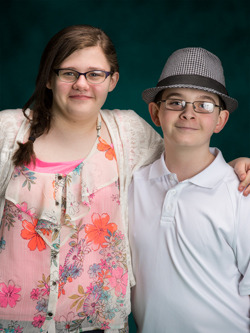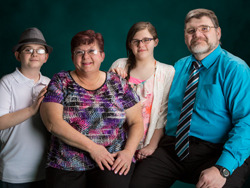Miracle Kid: Matthew Morgan
Life-Changing Technology Allows Scoliosis Patient to Thrive
Matthew Morgan learned firsthand that an operating room isn’t the most fun place in the world for a 5-year-old.
And it wasn’t that fun when he was 6, either.
Or 7.
Or 8. Or 9. Or 10.
But this was his reality. Every six months, Matthew would come into UR Medicine’s Golisano Children’s Hospital for another surgery, so doctors could adjust the metal rods in his back, allowing him to grow while keeping his scoliosis in check.
That meant general anesthesia, the re-opening of a long scar in his back, and an adjustment or full replacement of the growing rods supporting his spine. Every six months.
“It was always scary,” said Sue Morgan, Matthew’s mother. “It’s a surgery they do a lot, but it’s still hard. You’re always wondering if he’s going to be OK. We learned to adjust after a while, but it takes a toll on everyone.”
But in early 2014, a new device offered hope to the Morgan family. Soon, an every-six-months surgery would be a thing of the past.
Matthew’s journey started early. Three months earlier than anyone was expecting, actually. Born prematurely, he spent three months in the Neonatal Intensive Care Unit. Then, after a month at home, he was re-admitted to the hospital after struggling to put on weight.
“That alone right there was a miracle, because he wasn’t expected to make it,” said Sue Morgan.
 His parents first noticed his scoliosis when he was 9 months old. They soon found their way to Shriners Hospital for Children in Erie, Pa., where James Sanders, M.D., began providing Matthew’s care.
His parents first noticed his scoliosis when he was 9 months old. They soon found their way to Shriners Hospital for Children in Erie, Pa., where James Sanders, M.D., began providing Matthew’s care.
First, Matthew was fitted for a series of casts. These casts, which were replaced every few months, helped to stabilize his spine until he was old enough for his first surgery.
The Morgans were so happy with Matthew’s care during this time that when they learned in 2008 that Sanders was heading to Rochester to join Golisano Children’s Hospital, they followed him to the area, moving to a home in Henrietta.
“We’ve just gotta have our Dr. Sanders,” said Sue Morgan.
In Rochester, Matthew’s growing rod surgeries continued.
“Severe scoliosis can have serious consequences. The curve of the spine can cause the lungs to fail if it goes unchecked,” said Sanders. “The regular surgeries are an unfortunate part of what children sometimes have to go through. But we want to make sure they can grow, physically, to the same level they otherwise would have.”
Matthew and his parents knew that it would be a long process. And for years, they worked with Sanders to keep Matthew’s spine as healthy as possible. By early 2014, Matthew had gone through surgery 13 times in all.
 But a new device being used in England and Hong Kong was earning rave reviews from physicians and parents. Developed in the United States and named the MAGEC System, the device was a growing rod powered by a magnetic motor that doctors could adjust via external remote, without the need for surgery. In February 2014, the Food and Drug Administration approved it for use in the United States.
But a new device being used in England and Hong Kong was earning rave reviews from physicians and parents. Developed in the United States and named the MAGEC System, the device was a growing rod powered by a magnetic motor that doctors could adjust via external remote, without the need for surgery. In February 2014, the Food and Drug Administration approved it for use in the United States.
As soon as Sue Morgan heard about the FDA approval, she emailed Sanders, who was also closely watching the process.
“As soon as I sent him the email, he said that we’d set something up – they got an appointment on the books as soon as they could,” said Sue Morgan.
Matthew had his surgery soon thereafter. Thanks in part to Sanders’s advocacy, Golisano Children’s Hospital was just the second hospital in the country to use the magnetic growing rods following the FDA approval.
When Matthew woke from surgery, he was given a memento to take home: the old set of growing rods that had been in his back.
Today, his growing rod adjustments are far less harrowing. He goes to an outpatient clinic once a month where he lies down on his stomach as Sanders pilots the magnetic remote over his back.
“It doesn’t hurt at all,” said Matthew, who is now 11 years old. “It kind of tickles.”
The regular trips allow Sanders to make subtle adjustments to the growing rods on a more frequent basis. And without the need for surgery, it’s much easier for Matthew, who can devote his time to playing with his two dogs and three cats, or settling in for some Minecraft when the weather doesn’t cooperate.
When it comes to surgery, he’s not out of the woods yet. Even the magnetic growing rods don’t last forever, and will need to be replaced occasionally as Matthew grows.
But eventually, Matthew will be old enough for a spinal fusion, which will end the growing rod cycle once and for all. And the time until his next surgery is now counted in years, not months.
“It’s just really nice not to have to do that any more,” Matthew said.